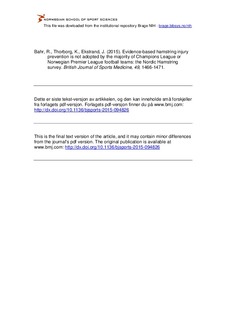| dc.contributor.author | Bahr, Roald | |
| dc.contributor.author | Thorborg, Kristian | |
| dc.contributor.author | Ekstrand, Jan | |
| dc.date.accessioned | 2016-05-25T12:45:03Z | |
| dc.date.available | 2016-05-25T12:45:03Z | |
| dc.date.issued | 2015-05-20 | |
| dc.identifier.citation | British Journal of Sports Medicine. 2015, 49,1466-1471 | nb_NO |
| dc.identifier.uri | http://hdl.handle.net/11250/2390432 | |
| dc.description | Dette er siste tekst-versjon av artikkelen, og den kan inneholde små forskjeller fra forlagets pdf-versjon. Forlagets pdf-versjon finner du på www.bmj.com: http://dx.doi.org/10.1136/bjsports-2015-094826 / This is the final text version of the article, and it may contain minor differences from the journal's pdf version. The original publication is available at www.bmj.com: http://dx.doi.org/10.1136/bjsports-2015-094826 | nb_NO |
| dc.description.abstract | Background: The Nordic hamstring (NH) exercise programme was introduced in 2001 and has been shown to reduce the risk of acute hamstring injuries in football by at least 50%. Despite this, the rate of hamstring injuries has not decreased over the past decade in male elite football.
Aim: To examine the implementation of the NH exercise programme at the highest level of male football in Europe, the UEFA Champions League (UCL), and to compare this to the Norwegian Premier League, Tippeligaen, where the pioneer research on the NH programme was conducted.
Design: Retrospective survey.
Setting/participants 50 professional football teams, 32 from the UCL and 18 from Tippeligaen.
Methods: A questionnaire, based on the Reach, Efficacy, Adoption, Implementation and Maintenance framework, addressing key issues related to the implementation of the NH programme during three seasons from 2012 through 2014, was distributed to team medical staff using electronic survey software.
Results: The response rate was 100%. Of the 150 club-seasons covered by the study, the NH programme was completed in full in 16 (10.7%) and in part in an additional 9 (6%) seasons. Consequently, 125 (83.3%) club-seasons were classified as non-compliant. There was no difference in compliance between the UCL and Tippeligaen in any season (χ2: 0.41 to 0.52).
Conclusions: Adoption and implementation of the NH exercise programme at the highest levels of male football in Europe is low; too low to expect any overall effect on acute hamstring injury rates. | nb_NO |
| dc.language.iso | eng | nb_NO |
| dc.publisher | BMJ Publishing Group | nb_NO |
| dc.title | Evidence-based hamstring injury prevention is not adopted by the majority of Champions League or Norwegian Premier League football teams: The Nordic Hamstring survey | nb_NO |
| dc.type | Journal article | nb_NO |
| dc.type | Peer reviewed | nb_NO |
| dc.subject.nsi | VDP::Social science: 200 | nb_NO |
| dc.subject.nsi | VDP::Social science: 200::Social science in sports: 330 | nb_NO |
| dc.subject.nsi | VDP::Social science: 200::Social science in sports: 330::Other subjects within physical education: 339 | nb_NO |
| dc.source.journal | British Journal of Sports Medicine | nb_NO |
| dc.description.localcode | Seksjon for idrettsmedisinske fag / Department of Sports Medicine | nb_NO |
